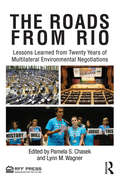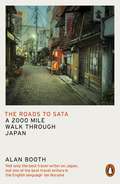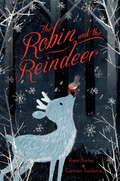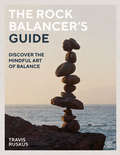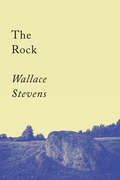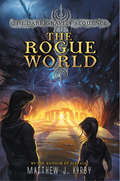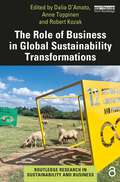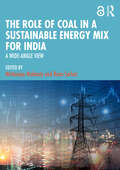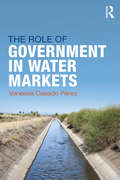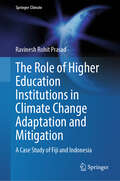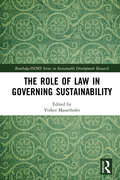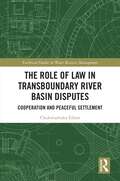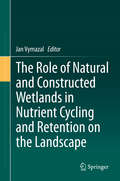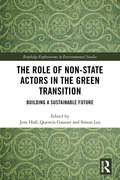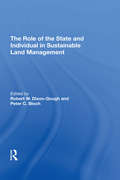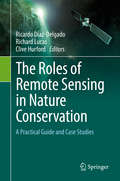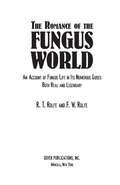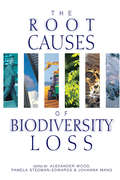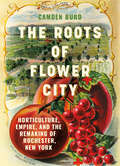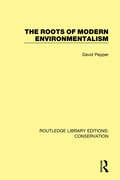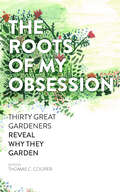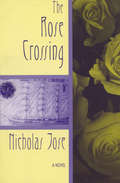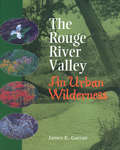- Table View
- List View
The Roads from Rio: Lessons Learned from Twenty Years of Multilateral Environmental Negotiations
by Pamela S. Chasek Lynn M. WagnerAt the 1992 United Nations Conference on Environment and Development, popularly known as the Rio Earth Summit, the world’s leaders constructed a new "sustainable development" paradigm that promised to enhance environmentally sound economic and social development. Twenty years later, the proliferation of multilateral environmental agreements points to an unprecedented achievement, but is worth examining for its accomplishments and shortcomings. This book provides a review of twenty years of multilateral environmental negotiations (1992-2012). The authors have participated in most of these negotiating processes and use their first-hand knowledge as writers for the International Institute for Sustainable Development’s Earth Negotiations Bulletin as they illustrate the changes that have taken place over the past twenty years. The chapters examine the proliferation of meetings, the changes in the actors and their roles (governments, nongovernmental organizations, secretariats), the interlinkages of issues, the impact of scientific advice, and the challenges of implementation across negotiating processes, including the Framework Convention on Climate Change, the Convention to Combat Desertification, the Convention on Biological Diversity, the Commission on Sustainable Development, the UN Forum on Forests, the chemicals conventions (Stockholm, Basel and Rotterdam), the Montreal Protocol on Substances that Deplete the Ozone Layer, the Convention on International Trade in Endangered Species, the Convention on Migratory Species and the International Treaty on Plant Genetic Resources for Food and Agriculture.
The Roads to Sata: A 2000-mile walk through Japan
by Alan Booth'A memorable, oddly beautiful book' Wall Street Journal'A marvellous glimpse of the Japan that rarely peeks through the country's public image' Washington PostOne sunny spring morning in the 1970s, an unlikely Englishman set out on a pilgrimage that would take him across the entire length of Japan. Travelling only along small back roads, Alan Booth travelled on foot from Soya, the country's northernmost tip, to Sata in the extreme south, traversing three islands and some 2,000 miles of rural Japan. His mission: 'to come to grips with the business of living here,' after having spent most of his adult life in Tokyo.The Roads to Sata is a wry, witty, inimitable account of that prodigious trek, vividly revealing the reality of life in off-the-tourist-track Japan. Journeying alongside Booth, we encounter the wide variety of people who inhabit the Japanese countryside - from fishermen and soldiers, to bar hostesses and school teachers, to hermits, drunks and the homeless. We glimpse vast stretches of coastline and rambling townscapes, mountains and motorways; watch baseball games and sunrises; sample trout and Kilamanjaro beer, hear folklore, poems and smutty jokes. Throughout, we enjoy the wit and insight of a uniquely perceptive guide, and more importantly, discover a new face of an often-misunderstood nation.
The Robin and the Reindeer
by Rosa BaileyA little reindeer, lost in the forest ... and a robin, who will help her fly home; this is a gift book for children and parents to treasure.Little Reindeer is lost in the forest.It begins to snow. And as the snowflakes crowd through the trees, she catches a glimpse of something: a flash of startling red and wings blurring in the air. A robin! In a piece of woodland magic, the generous robin lends the red from his feathers to Little Reindeer's nose, and they fly home together. A perfect gift book for the winter season, with a gorgeous foiled and textured cover. For anyone who loves The Snowman by Raymond Briggs, or The Fox and the Star by Coralie Bickford-Smith.
The Rock Balancer's Guide: Discover the Mindful Art of Balance
by Travis RuskusThe first mainstream book about rock balancing, combining inspiring full-colour photographs with practical guidance on how to balance rocks and, in the process, let go of limiting beliefs and find happiness in the present moment.Rock balancing is the practice of piling up stones in natural settings, creating everything from simple towers to amazingly elaborate and apparently gravity-defying edifices. People balance rocks for fun, to challenge themselves and as a way of being mindful, connecting to nature and focusing on the present moment. This is the first mainstream book about the meditative art of rock balancing, combining technical advice on creating the structures with c. 40 spectacular colour photographs of the author's own balances, as well as guidance on approaching rock balancing as a mindfulness/meditation practice. As the book guides you through the practical techniques of rock balancing, it also explains how to breathe properly, how to approach the rocks with self-belief, face fear and go beyond what you had previously thought to be your limits. Finally, it discusses how to let go and destroy the balances you have created, leaving nature in a pristine state. The book includes inspirational quotes, tips and step-by-step instructions for beginner and more advanced rock balancers, as well as a range of meditative exercises to do while balancing, and fun challenges, such as balance 10 rocks from the biggest to smallest, balance a rock on the top of your head and balance three rocks in an impossible way. A rock balance is a metaphor for whatever you are trying to achieve in life - and this practice allows you to train yourself to do more than you ever thought possible.
The Rock Garden (Fountas & Pinnell LLI Gold #Level P)
by Nancy WhiteStep into the Rock Garden of Chandigarh in India, it's like entering a magical world.
The Rock: Poems (Counterpoints #4)
by Wallace StevensAn excellent introduction to “the best and most representative American poet” (Harold Bloom), this palm–sized, keepsake edition is the first separate publication of this remarkable collection of late poems.In 1955, shortly before his death, Wallace Stevens earned the Pulitzer Prize for Poetry and the National Book Award for The Collected Poems of Wallace Stevens. The collection gathered most of his life’s work, and featured 25 previously unpublished poems. Stevens imagined that those poems would stand alone as their own volume—The Rock. Featuring some of his most memorable poems, including “Not Ideas about the Thing but the Thing Itself,” The Rock is a sublime selection of works from one of American’s most brilliant, beloved modernist.“After the reader has admired certain lines because Shakespeare might have written them, he begins to admire them because only Stevens could.” —Robert Fitzgerald“One might as well argue with the Evening Star and find fault with so much wit and grace and intelligence . . . such an overwhelming and exquisite command both of the worlds and of the rhythms of our language; such charm and irony, such natural and philosophical breadth of sympathy, such dignity and magnanimity.” —Randall Jarrell
The Rogue World
by Matthew J. KirbyPerfect for fans of the Percy Jackson and Seven Wonders series, The Rogue World is the third book in an epic, fast-paced middle grade adventure trilogy by acclaimed author Matthew J. Kirby.After the shattering new discoveries they made in Egypt, Eleanor and her mother, Samantha, have been separated: Samantha working with the sinister Dr. Watkins to ensure the survival of only a small number of humans, and Eleanor and her friends uniting in the desperate hope of saving the entire planet. They are preparing for a trek to the icy Himalayas, where they believe they’ll find the Master Concentrator and a chance to end the threat of the rogue planet—one way or the other. But that’s when something happens that none of them expected: an alien spacecraft crash lands on earth, throwing the globe into crisis and changing everything for Eleanor. She has just begun to understand the mysterious power that sets her apart from everyone else on the planet; now, everything rests on her ability to control the same alien intelligence that has pushed us to the brink of extinction.
The Role of Business in Global Sustainability Transformations (Routledge Research in Sustainability and Business)
by Robert Kozak Anne Toppinen Dalia D’AmatoDrawing on contributions from more than thirty scholars and experts in the field, this book examines the role of business as an enabler, as an inhibitor, and ultimately as a co-actor in global sustainability transformations expected over the next few decades. The Role of Business in Global Sustainability Transformations employs several theoretical perspectives and provides abundant examples and cases to discuss a variety of emerging concepts, phenomena, and trends shaping business sustainability. Weaving through the chapters, the editors present core tensions and sources of inertia towards transformative change, and acknowledge that envisioning multiple solutions and pathways are possible and desirable. They advocate for the need to align visions, actions and time horizons between policy, society and business in addressing the interlinked socio-ecological challenges that our society currently faces. This book will be an important resource for scholars and professionals working in the field of sustainability and sustainable business, and a vital educational text for students interested in this discipline.
The Role of Coal in a Sustainable Energy Mix for India: A Wide-Angle View
by Mritiunjoy Mohanty and Runa SarkarAs India switches away from a coal-based to a more sustainable energy use pattern, which pathway will it adopt? What is the nature of challenges that it will face, and who will be affected? Who will gain? This volume offers insights into the steps and challenges involved in this transition and addresses some urgent questions about the possible pathways for India’s renewable energy generation. Including contributions from researchers, policymakers, and practitioners, it draws on different disciplines, ranging from science and technology to economics and sociology, and situates the issue of low carbon transition within an interdisciplinary framework. India has committed to gradual decarbonisation of its economy. This book takes this as its starting point and uses a wide-angle lens, incorporating macro as well as micro views, to understand the possible next steps as well as trade-offs that will inevitably be posed. It incorporates the perspectives of all stakeholders ranging from central and state governments, public and private sector firms, on the one hand, to individuals and local communities, on the other, to explore their role in the transition, their interests, and how these will change and evolve. This timely volume will be of interest to students and researchers of environmental studies, development studies, environmental economics, political studies, and Asian studies. It will also be useful to academics, practitioners, and policymakers working on issues related to climate change, sustainable development, energy policy and economics,and public policy.
The Role of Government in Water Markets
by Vanessa Casado-PerezWhile water is an increasingly scarce resource, most existing methods to allocate it are neither economically nor environmentally efficient. In these circumstances, water markets offer developed countries a form of regulatory response capable of overcoming many of the shortcomings of current water management. The debate on water markets is, however, a polarized one. This is mostly a result of the misunderstanding of the roles played by governments in water markets. Proponents mistakenly portrayed them as leaving governments, for the most part, out of the picture. Opponents, in turn, understand commodification of water and administration by public agencies as incompatible. Casado Pérez argues that both sides of the debate overlook that water markets require a deeper and more varied governmental intervention than markets for other goods. Drawing on economic theories of regulation based on market failure, she explains the different roles governments should play to ensure a well-functioning water market, and concludes that only the visible hand of governments can ensure the success of water markets. Casado Pérez proves her case by examining case studies of California and Spain to assess the success of their water markets. She explores why water markets were more extensively institutionalized in California than in Spain in the first ten years since their introduction and how the role of governments in each case study impacted water market operation. This unique analysis of governmental roles in water markets, alongside qualitative studies of California and Spain, offers valuable guidance to understand environmental markets and to face the challenges presented by water management in regions with periodical droughts.
The Role of Higher Education Institutions in Climate Change Adaptation and Mitigation: A Case Study of Fiji and Indonesia (Springer Climate)
by Ravinesh Rohit PrasadThis book provides the readers with a description of climate change and the role of the University in promoting climate change education. It explores the Higher Education Institutions (HEIs) curriculum at various universities worldwide and how they have incorporated climate change into the university-wide programs. The book also looks at the causes and impacts of climate change and the countries most affected by this phenomenon, particularly Fiji and Indonesia. It describes how the various sectors, such as health, agriculture, and tourism, have been impacted by climate change. This book also summarizes the roles of United Nations Organizations in implementing climate change education at universities. The importance of climate change education is expressed in terms of adaptation and mitigation and to foster resilience, adaptability, and adaptation to climate change. The role of university student organizations aimed at environmental protection for climate change adaptation and mitigation is also discussed in this book.
The Role of Law in Governing Sustainability (Routledge/ISDRS Series in Sustainable Development Research)
by Volker MauerhoferThis book explores how public and private actors can interrelate to achieve also by means of law a sustainable development which is beneficial for the environment, society and the economy. The Role of Law in Governing Sustainability assesses the structure, functions and perspectives of law in the wider governance frameworks of sustainable development. It provides latest and in-depth insights from each of the three dimensions of sustainable development and the relations among them. Latest political developments on global and regional level related to the environmental, social and the economic dimensions are provided as well as in-depth case studies. Thereby the book explores how international and national laws and governance can help us move towards a more sustainable future. This book will be of great interest to students and scholars of environmental law, global governance and sustainable development.
The Role of Law in Transboundary River Basin Disputes: Cooperation and Peaceful Settlement (Earthscan Studies in Water Resource Management)
by Chukwuebuka EdumThis book examines the role legal rules play in the resolution of disputes in transboundary river basins. When states fail to resolve disputes over shared water resources, many cast such failures on inadequate or ineffective legal rules. With this view in mind, this book examines the role that legal rules do, and can, play in aiding the peaceful settlement of disputes and furthering cooperation between different parties. Building on the interactional theory of law, this book formulates three analytical frameworks: the effect of norm-generating processes, the effects of water-related agreements and/or arrangements in the basins, and the effect of international water. It uses these frameworks to assess the role of law in the processes of cooperation and peaceful settlement of disputes on transboundary river basin by drawing on four illustrative case studies: the Jordan River Basin, the Nile River Basin, the Mekong River Basin, and the Indus River Basin. In doing so, this book presents a unique perspective on the multi-functional role of legal rules in those processes. Tapping into the global discussion on water security and water-related conflicts, this book stimulates readers to explore broader or interdisciplinary perspectives for understanding water-related issues. This book will be of great interest to students and scholars interested in water resource management, water law, environmental politics, conflict resolution, and sustainable development more generally.
The Role of Natural and Constructed Wetlands in Nutrient Cycling and Retention on the Landscape
by Jan VymazalNatural and constructed wetlands play a very important role on the landscape and their ecological services are highly valuable. In fact, some wetland types are regarded as one of the most valuable ecosystems on the Earth. Water management, including flood water retention, biomass production, carbon sequestration, wastewater treatment and biodiversity sources, are among the most important ecological services of wetlands. The book is aimed at the use of constructed wetlands for wastewater treatment and for the evaluation of various ecosystem services of natural wetlands. Special attention is paid to the role and potential use of wetlands on the agricultural landscape. The book presents up-to-date results of ongoing research and the content of the book could be used by wetland scientists, researchers, engineers, designers, regulators, decision-makers, universities teachers, landscape engineers and landscape planners as well as by water authorities, water regulatory offices or wastewater treatment research institutions.
The Role of Non-State Actors in the Green Transition: Building a Sustainable Future (Routledge Explorations in Environmental Studies)
by Jens Hoff Quentin Gausset Simon LexThis book argues that there is no way to make progress in building a sustainable future without extensive participation of non-state actors. The volume explores the contribution of non-state actors to a sustainable transition, starting with citizens and communities of different kinds and ending with cities and city-networks. The authors analyse social, cultural, political and economic drivers and barriers for this transition, from individual behaviour to structural restraints, and investigate interplay between the two. Through a series of wide-ranging case studies from the UK, Australia, Germany, Italy and Denmark, and a number of comparative case studies, the volume provides an empirically and theoretically robust argument that highlights the need to develop, widen and scale up collective action and community-based engagement if the transition to sustainability is to be successful. This book will be of great interest to students and scholars of climate change, sustainability and environmental policy.
The Role of the State and Individual in Sustainable Land Management (International Land Management Ser.)
by Peter C. BlochBringing together case studies from Europe, Africa and North and South America, this book makes a fresh assessment of the role of the individual and the state in land development. It discusses a range of issues related to land reform, land development and land management, providing a unique reflection of the current state of research. Particular emphasis is laid on the implementation of sustainable processes of land development as an integrated principle of land management. The book examines the rights of the land users and addresses a number of issues relating to sustainability and land development, ranging from emerging land markets and environmental issues, through to natural resource development. The case studies provide practical examples of the application of land reform and land development to land management.
The Roles of Remote Sensing in Nature Conservation
by Clive Hurford Richard Lucas Ricardo Díaz-DelgadoThe book will provide an overview of the practical application of remote sensing for the purposes of nature conservation as developed by ecologists in collaboration with remote sensing specialists, providing guidance on all phases from the planning of remote sensing projects for conservation to the interpretation and validation of the images.
The Romance of the Colorado River
by Frederick S. DellenbaughIn 1871, seventeen-year-old Fred Dellenbaugh walked into a hotel room in Chicago, and with a “You’ll do, Fred,” began a lifetime of danger-fraught exploration. Under the lead of John Wesley Powell, a Civil War hero with only one arm, Fred journeyed into the Grand Canyon and its subsidiary canyons and rivers, with the intention of exploring, mapping, and recording description of the uncharted territory. The men found themselves battling the great force of the Colorado River, with its fatal, quick rapids and mighty waterfalls. Their small, frail boats were no match for the river, and as they began to capsize and as supplies were lost overboard, the expedition quickly became about survival. It was only through the steady command of Major Powell that the team prevailed. They went on to accomplish their mission, which has become historically significant today. <P><P> The Romance of the Colorado River is Dellenbaugh’s personal story, written thirty years after the great adventure. The volume includes twenty of the author’s original illustrations, as well as nearly 150 contemporary photographs, which provide an accurate image of what the explorers encountered during their expedition. Dellenbaugh also recounts previous attempts to explore the valley, by both Europeans and fellow Americans, adding a historical element to the story. Part adventure narrative and part geography survey of the Colorado River, this book offers a unique firsthand account of a fascinating scientific expedition.
The Romance of the Fungus World: An Account of Fungus Life in Its Numerous Guises Both Real and Legendary
by R. T. RolfeMankind has always had a love-hate relationship with fungi. On the positive side, edible mushrooms and truffles are gastronomic delights, and certain fungi possess medicinal properties. On the other hand, many mushrooms are poisonous, and fungi can inflict costly damage on crops and other property. This captivating book explores both sides of the story, examining aspects usually overlooked in texts and field guides.The survey begins with fungi lore from mythology and legends, focusing particularly on the plants' association with devils, witches, and fairies. A balanced portrait of fungi in the real world considers not only the ruin caused by the plants but also their uses in medicine and industry and as foods. Ranging far and wide in its topics, the narrative offers a light touch and plenty of enthusiasm, making this book fun for everyone with even a casual interest in mushrooms. In addition, serious mushroom hunters will find this volume a practical reference and a fascinating resource for leisurely browsing.
The Root Causes of Biodiversity Loss
by Alexander Wood Pamela Stedman-Edwards Johanna MangThe world is losing species and biodiversity at an unprecedented rate. The causes go deep and the losses are driven by a complex array of social, economic, political and biological factors at different levels. Immediate causes such as over-harvesting, pollution and habitat change have been well studied, but the socioeconomic factors driving people to degrade their environment are less well understood. This book examines the underlying causes. It provides analyses of a range of case studies from Brazil, Cameroon, China, Danube River Basin, India, Mexico, Pakistan, Philippines, Tanzania and Vietnam, and integrates them into a new and interdisciplinary framework for understanding what is happening. From these results, the editors are able to derive policy conclusions and recommendations for operational and institutional approaches to address the root causes and reverse the current trends. It makes a contribution to the understanding of all those - from ecologists and conservationists to economists and policy makers - working on one of the major challenges we face.
The Roots of Flower City: Horticulture, Empire, and the Remaking of Rochester, New York
by Camden BurdIn The Roots of Flower City, Camden Burd explores the economic and ecological significance of Rochester plant nurserymen over the course of the nineteenth century. As the first boomtown in the United States, Rochester was an embodiment of nineteenth-century market economies and social reform movements. Connected to the eastern seaboard by the Erie Canal, the city's unique economic, cultural, and environmental conditions fostered and sustained a vast and influential commercial plant nursery industry that attracted the nation's most prominent horticulturists and nurserymen. Rochester-area nurserymen built parks and rural cemeteries, landscaped homes and schools, and promoted horticultural pursuits regionally and nationally. As their influence grew, many of these horticultural entrepreneurs developed into the city's elite and played a leading role in shaping Rochester's economic, social, and physical landscape. Most significantly, nurserymen enthusiastically participated in the American imperial project, selling and distributing fruit, shade, and ornamental trees, shrubs, and flowers across the continent, transforming landscapes and ecologies far beyond New York. The Roots of Flower City tells the remarkable history of Rochester's outsized influence on the homes, estates, towns, and cities of nineteenth-century America as it weathered economic downturns and competition from other regions. One threat, however, proved to be too much to overcome. As Burd details, the spread of the destructive San Jose scale through the transcontinental plant trade prompted federal legislation that would lead to the decline of the Rochester plant nursery industry in the last decade of the nineteenth century, ending a sustained era of success and ecological impact.
The Roots of Modern Environmentalism (Routledge Library Editions: Conservation #6)
by David PepperOriginally published in 1984, The Roots of Modern Environmentalism provides a historical, philosophical and ideological background to environmentalism. Topics covered include, the roots of technological environmentalism, the medieval cosmology and Bacon’s philosophy, the non-scientific roots of ecological environmentalism, such as Romanticism and its scientific roots in the theories of Malthus and Darwin. The Marxist perspective on Nature is also discussed. The concluding chapter is a criticism of education which challenges its usefulness as an agent of socio-economic change. This book will be of interest to academics and students of environmentalism and geography.
The Roots of My Obsession: Thirty Great Gardeners Reveal Why They Garden
by Thomas C. CooperWhy do you garden? For fun? Work? Food? The reasons to garden are as unique as the gardener.The Roots of My Obsession features thirty essays from the most vital voices in gardening, exploring the myriad motives and impulses that cause a person to become a gardener. For some, it’s the quest to achieve a personal vision of ultimate beauty; for others, it’s a mission to heal the earth, or to grow a perfect peach. The essays are as distinct as their authors, and yet each one is direct, engaging, and from the heart. For Doug Tallamy, a love of plants is rooted first in a love of animals: “animals with two legs (birds), four legs (box turtles, salamanders, and foxes), six legs (butterflies and beetles), eight legs (spiders), dozens of legs (centipedes), hundreds of legs (millipedes), and even animals with no legs (snakes and pollywogs).” For Rosalind Creasy, it’s “not the plant itself; it’s how you use it in the garden.” And for Sydney Eddison, the reason has changed throughout the years. Now, she “gardens for the moment.” As you read, you may find yourself nodding your head in agreement, or gasping in disbelief. What you’re sure to encounter is some of the best writing about the gardener’s soul ever to appear. For anyone who cherishes the miracle of bringing forth life from the soil, The Roots of My Obsession is essential inspiration.
The Rose Crossing: A Novel
by Nicholas Jose&“A fable, set in the 17th century, filled with vivid evocations of another time [and] wonderfully peculiar characters.&” —Kirkus Reviews To escape Puritan England, naturalist Edward Popple signs on to be a ship&’s doctor on a journey across the Indian Ocean, and his daughter, Rosamund, stows away to accompany him. But a wreck leaves them stranded on an island off the coast of Africa. Amid the lush vegetation, the birds and the sea turtles, father and daughter set about exploring, Edward passionately studying the island&’s horticulture and Rosamund wandering about to discover its mysteries. Then a Chinese ship, with the last heir to the Ming dynasty among its passengers, arrives—and changes everything. &“The prose is ripe, laden with a sense of the forbidden, and with doom.&” —Publishers Weekly &“A luminous historical novel.&” —Booklist Online
The Rouge River Valley: An Urban Wilderness
by James E. GarrattThe Rouge River Valley, eleven thousand acres of urban wilderness, is a unique, yet very fragile and transient natural phenomenon existing within the confines of a major North American city, Toronto. Fed by the Oak Ridges Moraine, the Rouge river system has, over generations of time, cut its identity into the land, shaping the habitat for a multitude of lifeforms, many of which are now either threatened or gone. Author James E. Garratt, a seasoned environmentalist, shares two decades of personal observation and ecological study to reveal the richness and flow of seasonal changes in this exceptional urban park. This "portrait" of a year in the Rouge Valley explores not only the diversity of life in its natural habitat but also the impact of urban sprawl and the inevitable conflict with development. Is it possible to be a true naturalist "grounded" in a modern city? The words of Ian McHarg, an urban planner, hold true: "We need nature as much in the city as in the country."
